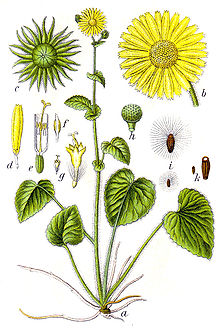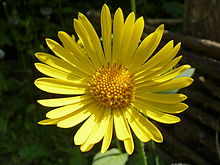Creeping chamois
| Creeping chamois | ||||||||||||
|---|---|---|---|---|---|---|---|---|---|---|---|---|

Creeping chamois ( Doronicum pardalianches ) |
||||||||||||
| Systematics | ||||||||||||
|
||||||||||||
| Scientific name | ||||||||||||
| Doronicum pardalianches | ||||||||||||
| L. |
The crawling Gämswurz ( doronicum pardalianches ), also Crawling Gemswurz written is a plant from the genus Doronicum ( doronicum ) in the family Compositae (Asteraceae). It is native to the northeast Iberian Peninsula and Central Europe.
description
Appearance and foliage leaf
The creeping chamois grows as a perennial herbaceous plant and usually reaches heights of 50 to 100 (up to 150) centimeters. It forms long, subterranean, fleshy, more or less downy hairy to bald rhizomes as persistence organs; they are runners-like , sometimes ending with buds and thus lead to vegetative reproduction , thereby forming flat stands. There are shiny, white-tinted hairs ( trichomes ) on the nodes of the rhizomes . The upright stem, which is barely branched even in the upper area, is shaggy with hair and only leafed in the lower two thirds. The internodes are always longer than the nearby leaves.
The leaves are basal and alternately distributed on the stem. The basal leaves, which are sometimes still present at the time of flowering, have a simple leaf blade, which is 3.6 to 16.5 cm long and 3.3 to 14 cm wide, ovate with a broad heart-shaped base and blunt upper end, almost entire with hairs on both sides . The petiole of the basal leaves has a length of 4.5 to 27 cm and a diameter of 1 to 4.5 mm. The stem leaves are almost entire and hairy on both sides. The lower stem leaves are similar to the basal leaves and have a simple leaf blade that is 3.3 to 22 cm long and 2.3 to 11 cm wide. The densely hairy and weakly winged petiole of the lower stem leaves is usually 6 to 10 (3.4 to 27) cm long and 1 to 1.5 mm in diameter. The central stem leaves are sessile and encompass the stem and have a simple leaf blade that is usually 5 to 9 (2.7 to 15.3) cm long and 3 to 6 (1.6 to 10) cm wide and shaped like a violin. The upper stem leaves have a simple leaf blade that is usually from 2.6 to 6 (1 to 10) cm in length and from usually 1 to 2 (0.2 to 5.5) cm in width from ovate-elliptical to ovate-lanceolate is; they are sometimes bract-like.
Inflorescence and flower
The flowering period extends from May to early July. In a loose, umbelliferous total inflorescence, there are usually two to six (one to eight) cup-shaped partial inflorescences. The glandular hairy inflorescence shafts have a length of mostly 5 to 7 (0.5 to 20) centimeters and a diameter of mostly 0.8 to 1 (0.5 to 2) millimeters. The inflorescence envelope is as long as or sometimes longer than the ray florets and is 1 to 3.3 cm in diameter. The herbaceous bracts are egg-shaped and always with a length of usually 1.2 to 1.4 cm (1 to 1.7) and a width of usually 1 to 1.5 (0.7 to 2.7) mm pointed upper end. The bracts have pointed, stiff trichomes in several rows at equal intervals with ciliate edges and glandular or non-glandular trichomes on their surfaces. The inflorescence base is downy hairy or glabrous. The flower heads have a diameter of 2 to usually a good 5 cm up to the tips of the ray flowers.
The flower heads contain golden yellow tongue (= ray) and tubular flowers (= disc flowers). The ray florets have a length of 1.1 to 2.5 cm and a width of (1 to) mostly 2 to 3.5 mm elongated-elliptical with a three-lobed tongue. In tubular flowers, the crowns are 4 to 6 mm long and 1 to 2.5 mm in diameter.
fruit
The achenes have a black, warty surface and are different in the ray and disc flowers ( heterocarpy ). The bald achenes, 1.7 to 3.5 mm long and 0.7 to 1.3 mm wide, of the ray-flowers have no pappus . The hairy, 1.2 to 1.8 mm long and 0.7 to 1 mm wide achenes of the disc flowers have a white, (2.5 to) mostly 3 to 4 mm long pappus (crown of hair).
Chromosome number
The chromosome numbers are 2n = 60 (120).
Occurrence and use
The natural range of the creeping chamois includes the northeastern Iberian peninsula and Central Europe with France, Italy, Switzerland, Germany and the Netherlands. In other countries such as Belgium, Denmark, Sweden, Great Britain, Ireland and the Czech Republic it is a neophyte. It thrives at altitudes between 0 and 1800 meters in forests, meadows, hedges and along rivers . It occurs in societies of the associations Carpinion and Fagion.
The creeping chamois is nutrient-demanding and occurs in fresh deciduous forests and bushes. It is considered to be native to Germany.
It was planted earlier as a medicinal plant , later as an ornamental plant in gardens and parks, overgrown and naturalized as a neophyte .
Common names
The other German-language common names exist or existed for the creeping chamois : Althee ( Zillertal , Salzburg ), Althet, Dorantwurzel, chamois ( Lungau ), chamois, Graffoy, Kraftwurz ( Ulm ), vertigo, vertigo, vertigo ( Carinthia ) and forest roses ( Pinzgau , Fusch ).
swell
- Ines Álvarez Fernández: Systematics of Eurasian and North African Doronicum (Asteraceae: Senecioneae) , In: Annals of the Missouri Botanical Garden , 2003, Volume 90, Number 3, pp. 319-389. doi : 10.2307 / 3298534 scanned at biodiversitylibrary.org . Doronicum pardalianches on pages 373-375.
- Werner Rothmaler (founder), Eckehart J. Jäger, Klaus Werner (ed.): Exkursionsflora von Deutschland, Volume 4, Vascular Plants: Critical Volume . 9th edition. Spektrum Akademischer Verlag, Heidelberg, Berlin 2002, ISBN 3-8274-0917-9
- Henning Haeupler, Thomas Muer: picture atlas of the fern and flowering plants of Germany . Ed .: Federal Agency for Nature Conservation (= The fern and flowering plants of Germany . Volume 2 ). Eugen Ulmer, Stuttgart (Hohenheim) 2000, ISBN 3-8001-3364-4 .
- Creeping chamois. In: FloraWeb.de.
Individual evidence
- ↑ a b c d Henning Haeupler, Thomas Muer: picture atlas of the fern and flowering plants of Germany . Ed .: Federal Agency for Nature Conservation (= The fern and flowering plants of Germany . Volume 2 ). Eugen Ulmer, Stuttgart (Hohenheim) 2000, ISBN 3-8001-3364-4 .
- ↑ a b Werner Rothmaler (greeting), Eckehart J. Jäger, Klaus Werner (ed.): Exkursionsflora von Deutschland, Volume 4, Vascular Plants: Critical Volume . 9th edition. Spektrum Akademischer Verlag, Heidelberg, Berlin 2002, ISBN 3-8274-0917-9
- ↑ a b c d e Creeping chamois. In: FloraWeb.de.
- ↑ a b c d e f g h i j k l m n o p Ines Álvarez Fernández: Systematics of Eurasian and North African Doronicum (Asteraceae: Senecioneae) , In: Ann. Mon. Bot. Gard. , 2003, Volume 90, Number 3, pp. 319-389. doi : 10.2307 / 3298534 scanned at biodiversitylibrary.org . Doronicum pardalianches on pages 373-375.
- ↑ Werner Greuter (2006+): Compositae (pro parte majore). - In: W. Greuter & E. von Raab-Straube (ed.): Compositae. Euro + Med Plantbase - the information resource for Euro-Mediterranean plant diversity. Datasheet Doronicum pardalianches In: Euro + Med Plantbase - the information resource for Euro-Mediterranean plant diversity.
- ^ Erich Oberdorfer : Plant-sociological excursion flora for Germany and neighboring areas . With the collaboration of Angelika Schwabe and Theo Müller. 8th, heavily revised and expanded edition. Eugen Ulmer, Stuttgart (Hohenheim) 2001, ISBN 3-8001-3131-5 , pp. 949-950 .
- ^ Georg August Pritzel , Carl Jessen : The German folk names of plants. New contribution to the German linguistic treasure. Philipp Cohen, Hannover 1882, page 137. ( online ).
Web links
- Doronicum pardalianhes L., creeping chamois. In: FloraWeb.de.
- Creeping chamois . In: BiolFlor, the database of biological-ecological characteristics of the flora of Germany.
- Profile and distribution map for Bavaria . In: Botanical Information Hub of Bavaria .
- Doronicum pardalianches L. In: Info Flora , the national data and information center for Swiss flora . Retrieved May 18, 2016.
- Thomas Meyer: Gemswurz data sheet with identification key and photos at Flora-de: Flora von Deutschland (old name of the website: Flowers in Swabia )

